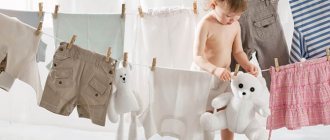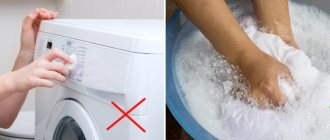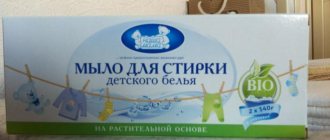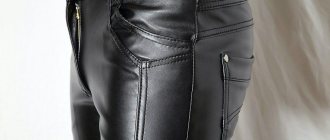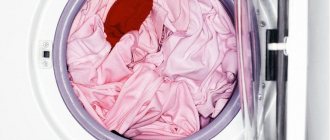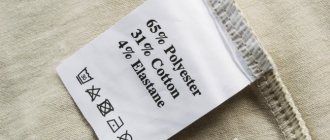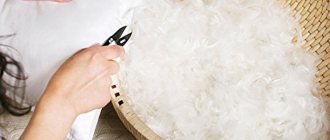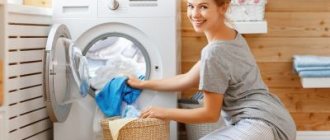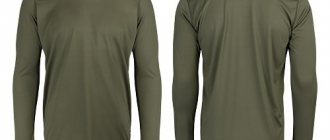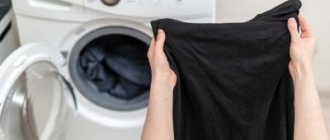Everyone knows that washing things regularly is important for your health. This is especially important if there is a child in the house. It should be carefully looked after, because babies have delicate skin and weak immunity. You should start by destroying harmful microorganisms. Of course, today it is much easier to wash thanks to the advent of modern technology, but you still need to take into account several features.
Basic washing rules
- Children's clothes should be washed separately from adults. If there is feces on them, you should first wash them off with water, and if necessary, rub them with a brush.
- It is better to wash things right away, as it is easier to put them in order while the dirt is fresh.
- If the clothes are very dirty, it is better to initially rinse them with water and leave them in a soapy solution for at least an hour.
- Be sure to rinse your children's things thoroughly, otherwise the remaining powder may cause itching.
- It is also better to dry children's clothes separately from adults; try to hang them so that dust from the street does not get on them.
- Ironing clothes on both sides is good for disinfection. Ironing is a must.
- It is better to wash mother’s things with special means, especially for women who are breastfeeding.
- Interestingly, the grandmothers believed that during the first month of a child’s life, his urine was clean, so it was enough to just dry the diapers and not wash them. However, it is better not to listen to such advice, but also to remember that there is nothing wrong with clothes washed at the wrong time.
Ironing
Children's underwear must be ironed on both sides and steamed to remove bacteria that have settled on it during drying. This point is especially relevant during the period when the umbilical wound has not yet healed. In addition, ironing will help make the linen soft and get rid of folds and creases that bother the baby.
Iron the fabric at the maximum permissible temperature and be sure to steam it thoroughly.
Store clean, ironed linen in a tightly closed children's chest of drawers. Its walls, outside and inside, must be regularly wiped from dust.
Using an iron
Selecting a detergent
The stores offer a wide range of different products for washing children's clothes. Be sure to study their composition, even if they are marked 0+. Until three months, you should only use simple baby soap, as it does not cause irritation. But powders based on it are not suitable due to the content of aggressive phosphates in them.
In the fourth month of life, you can use other washing products. But even then, do not buy powders with chlorine, phosphates and surfactants. Fragrance-free laundry gels are also a good choice. They remove dirt well and do not cause irritation in children.
Drying
It is important to dry washed clothes and other children's products according to all the rules.
Do not hang it outside, where there is a lot of dust, flies, and birds perch. It is preferable to organize drying conditions at home. You can purchase a compact folding floor dryer.
A convenient solution is to install a folding design on one of the walls of the bathroom with stretched cords. You can purchase retractable or ceiling-mounted varieties.
Drying things
The drying function, which is equipped with advanced washing machines, speeds up the process.
Knitted blouses are dried flat on a horizontal plane, having first spread a towel.
Machine washable
Of course, using an automatic machine is very convenient; you should choose a high temperature, then you can get rid of bacteria without difficulty. However, taking into account the fact that adult clothes are also washed in the same machine, this is not the best option. If you do wash there (and, most likely, this is what happens), give preference to the baby or delicate mode.
Up to a year, it is better not to wash adult shoes and outerwear in the same machine as children's clothes. It is better to avoid air conditioners and bleaches altogether.
At the end of the wash cycle, install an additional rinse to ensure that all chemical components are thoroughly removed from the clothing. Sometimes mothers grate baby soap and place it in the powder compartment; this is the most natural option.
Old stains
With the introduction of the first complementary foods, additional troubles arise with washing clothes. On the one hand, homogenized food is very convenient, because you don’t need to cook anything special, but on the other hand, you have to wash things much more often. You can get rid of severe dirt that has become embedded in a child’s clothes using traditional methods that are highly effective.
Important! Every parent should remember that it is forbidden to use aggressive substances and, in particular, chlorine! Products containing the designated component lead to acute allergic reactions in the baby, and the smell that clothes acquire after washing is almost impossible to remove. In addition, it is not recommended to use baking soda that remains on the fabric.
The best way to remove stains is regular peroxide. The advantages of this tool include:
- safety for the skin of a newborn;
- quick rinsing from fabric;
- effectiveness in removing even old stains;
- disinfecting effect.
At what degrees it is necessary to wash an item treated with peroxide depends on the fabric. However, most often experts recommend setting the temperature to 60 degrees. You should not raise the temperature, otherwise the laundry may acquire a grayish tint.
Mom’s forgetfulness is excusable, because the mass of worries with which she is surrounded does not allow her to keep absolutely everything in her head. Yellow stains formed due to lack of proper soaking and washing measures can be removed using a home recipe:
- 2 tablespoons of non-chlorine bleach are poured into a small container;
- a quarter cup of a spoonful of powder is added there;
- bulk substances are filled with 20 ml of expensive stain remover and the same amount of vegetable oil;
- the components are thoroughly mixed;
- Next, the mixture, diluted with water (five liters will be required), is put on fire;
- When the product boils, the fire is turned off and the composition is cooled to room temperature.
Diapers with old stains can be soaked in the indicated product for a day. Of course, you should not abuse such methods. It is only suitable for items made of light-colored fabric and is not used for dyed items. Upon completion of processing of dirty laundry, it must be washed with soap and rinsed thoroughly.
Hand wash
Not all parents have time for this, but it makes sense to wash certain stains this way. Do not forget about the following rules in this case.
It is worth sorting clothes by color and degree of soiling.
It is important to soak things in soapy water for a period of half an hour, for dirty clothes up to two hours.
The dirtiest places should be rubbed, some even twice.
Rinse in hot water once, and then twice more in warm water and once in cool water. As a result, the water should remain without soap foam.
The ideal solution would be to combine hand and machine washing. Items such as rompers, undershirts and caps should be washed by hand, but diapers, blankets and bed linen are best washed by machine.
Manually
Hand washing should be done at a sufficiently high temperature. You can use hot water at a tolerable temperature or wear two gloves on both hands - cotton and rubber.
Procedure:
- Washing powder or grated baby soap is diluted in prepared water.
- Dip children's clothes into soapy water.
- If there are stained areas on things, they should be treated separately (soap and rub).
- For better washing, it is advisable to soak things for at least 15 minutes.
- Rub your hands after soaking, paying attention to areas with stains.
- Drain the soapy water.
- Rinse things, changing the water at least 3 times.
You should rinse things not in hot, but in warm water. The last rinse is cold.
Washing new clothes
Not everyone knows that even brand new baby clothes need to be washed. Thanks to this, it is possible to get rid of paint residues and possible bacteria remaining on the clothes. Children's clothes are often treated with starch to give them a marketable appearance; it should also be washed out of new items in children's wardrobes. The same goes for diapers. Timely washing guarantees the health of children.
Items such as fur envelopes and other warm clothing are especially difficult to disinfect. In this case, you should use a steam generator or even a simple iron in steam mode instead of washing. Steam treatment must be done both inside and outside the item.
In front of the maternity hospital
When preparing things for the baby before the maternity hospital, you should inspect and wash them. This is necessary both for new things and for those passed down from older children. You can wash the first items by hand or use a machine for this.
To do this, you must comply with all requirements for the care of children's clothing, including:
- washing using products approved for newborns;
- thorough rinsing;
- ironing on both sides;
- storage after processing in a closed cellophane bag.
It is important to choose things made from natural materials, even if they are inferior in beauty to their synthetic counterparts. For the health of the newborn, all products must be made from hypoallergenic materials.
At what temperature should I wash?
Hand washing in hot water is, of course, problematic. You will have to stock up on cotton gloves, over which you need to put rubber ones. This way you will save your hands. It is much easier to machine wash; just set cotton to 90 degrees. At this temperature, undershirts, rompers, socks, caps, diapers and bedding are washed. Pay attention to the information on the label, it usually indicates the preferred washing temperature.
Colored items, as well as knitted ones, are washed at 40 degrees; if you set the temperature higher, they may lose their presentation. Woolen and other warm items are washed at only 30 degrees. This is true for suits, sweaters and overalls. But heavy dirt can only be removed at 90 degrees.
Many mothers wonder whether it is possible to boil children’s things. This method allows you to disinfect clothes and bedding, which is especially important after a child’s illness. Washing machines have a temperature of 95 degrees; this mode may well become an alternative to boiling. But diapers should not be boiled at all; a temperature of 40 to 60 degrees is sufficient for them. Only things that have lost their whiteness should be boiled.
Whitening
Yellowed duvet covers and other bedding items, as well as light-colored baby clothes, require bleaching measures.
It is recommended to use special varieties without chlorine and aggressive additives, intended directly for children's underwear and clothing. They are safe and easy to rinse.
Popular options:
- Maxima soap. It not only whitens, but also removes various stains. When washing by hand, pour water heated to 40˚C. Lather the product and carefully wipe off all dirt. Rinse three times.
- Gel "Hippo". Allows you to quickly restore the snow-white appearance of diapers, rompers, and bedding. Effectively copes with complex fruit and vegetable stains, marks from greenery and tea. Add 70-100 ml of gel to the washing machine. Effectively operates in the temperature range from 30 to 90˚С. You can hand wash at 60˚C using 70 ml of gel per 3 liters of water. Heavily soiled diapers are soaked by adding 90 ml of the product to hot (77-90˚C) water. Leave for an hour.
- Oxygen bleach of the Bos Plus brand Oxi. Shows good whitening results already at 30˚C. If you need to remove a stain, apply a little product to the mark, and then pour 30 ml into the washing machine compartment.
- Gel "Hippo" for whitening
You can choose other types of bleaches that will help maintain the snow-white appearance of children's clothes.
From the collection of popular advice for bedding sets for children over one year old, the following whitening techniques are practiced:
- Grind 3 standard aspirin tablets. Stir until completely dissolved in warm water - 150 ml. Before the main wash, soak the yellowed areas of the fabric in the solution for three hours.
- Combine a tablespoon of ammonia with twice the volume of hydrogen peroxide. Pour 2 liters of hot (70˚C) water into a bowl. The products are completely immersed in the solution for 30 minutes and then thoroughly washed with running water.
- Gently bleaches a solution of 3 liters of slightly warmed water and 2 tbsp of fine table salt. l. After three hours of soaking, rinse thoroughly.
- Dissolve without residue in hot (60-70˚C) water - 3 liters baking soda - 6 tbsp. l. For severe yellowness, add ammonia - 1 tbsp. l. The laundry is kept in this solution for 12 hours and washed with cool water.
- Pour citric acid into a liter of boiling water - 1 tsp. All stains on a white product are moistened generously using a sponge. After a quarter of an hour, place under running water.
ARTICLE FOR YOU
How to wash pillows: in the washing machine and by hand, bleach, dry
Bleaching procedures should not be carried out frequently so as not to cause rapid wear of the fabric.
How to store children's clothes?
A significant role is played not only by washing and ironing children's clothes, but also by their proper storage. After all, furniture and household items contain harmful bacteria and microorganisms. Therefore, for storage it is worth selecting a separate closet or chest of drawers, which should be washed from time to time.
Storage of children's clothing usually does not last long, because children's wardrobe items are often used and outgrown quickly. That's why it's worth placing them so that it's easy to get out. Place those items that need to be taken out especially often closest, and then those that need to be used less often. Store outerwear separately from other things.
